
The complete guide to app store localization (Google Play and the App Store)
App localization is a growth strategy you can’t ignore. If you’re launching or supporting your mobile app in only one language, you’re leaving serious growth on the table. Mobile app localization isn’t just a nice-to-have: it’s a core part of successful ASO and a powerful lever for driving user acquisition and engagement worldwide.
For mobile marketers, app store localization remains one of the most effective and often underused ways to boost visibility, improve conversions, and unlock growth in global markets. But to turn it into a real competitive advantage, you need more than just translations: you need a strategy.
In this guide, we’ll walk you through the entire mobile app localization process: from strategy to execution. You’ll learn why ASO localization is essential for scaling internationally, explore best practices and tools that streamline the process, discover how to avoid common mistakes, and see real-world examples of apps that got it right.
Whether you’re preparing your first app for global release or looking to improve your current app store localization efforts, this article is your roadmap to getting it right.
Key takeaways
- App localization is a powerful growth lever for international expansion, growing downloads, revenue, and user retention
- Localization goes beyond translation. It’s about adapting your app’s messaging, visuals, and user experience to connect with users in your target markets in a culturally relevant way.
- Strategic planning is critical. Prioritize markets based on data, conduct localized keyword research, and align both your store listing and in-app experience.
- Google Play and the App Store have unique localization requirements. Tailor your approach to the technical and creative expectations of each platform.
- Some of the common mistakes include skipping localization, launching too early, neglecting seasonal localization, and wasting budget on low-opportunity markets.
- Perform localization quality assurance with native reviewers to ensure accuracy and avoid confusing users.
- To achieve success, test and iterate to find out what’s most relevant for a specific market.
- Use tools to speed up and automate the process and get more data, track performance by region, and continuously optimize for maximum impact.
What is app localization and why is it important?
App localization is the process of adapting a mobile app’s content, design, and functionality to meet the cultural expectations of users in each target market.
Mobile app localization goes much beyond simple translation. It’s not just about translating the copy like app description and keywords to a specific language. App store localization is about adapting an app’s content and design to the cultural specificities of a particular market.
What works in Germany might not work in Japan, and vice versa. You should customize text, app screenshots, CTAs, and sometimes, even the icon, to make your app more “native” and relevant for a specific region.
Mobile app localization unlocks new users and is, therefore, crucial for growth.
App localization boosts these key metrics:
- Access to new markets: 80% of top-grossing app markets speak languages other than English.
- More downloads and revenue: A study found that adding a local language led to 128% more downloads and 26% higher revenue per country.
- Better visibility and credibility: Localizing app store listings to users’ native language can increase downloads by 38%.
Examples of app store localization
King’s Candy Crush Saga fully localizes its app store listings for every country. This helped Candy Crush reach over 3 billion downloads worldwide, proving that adapting an app to each locale can fuel massive global growth.
And guess what? King is a long-time client of AppTweak, utilizing our ASO intelligence to drive growth. Read King’s success story.
Here’s an example of Candy Crush Saga, localizing its U.S. App Store screenshots for the Spanish audience.
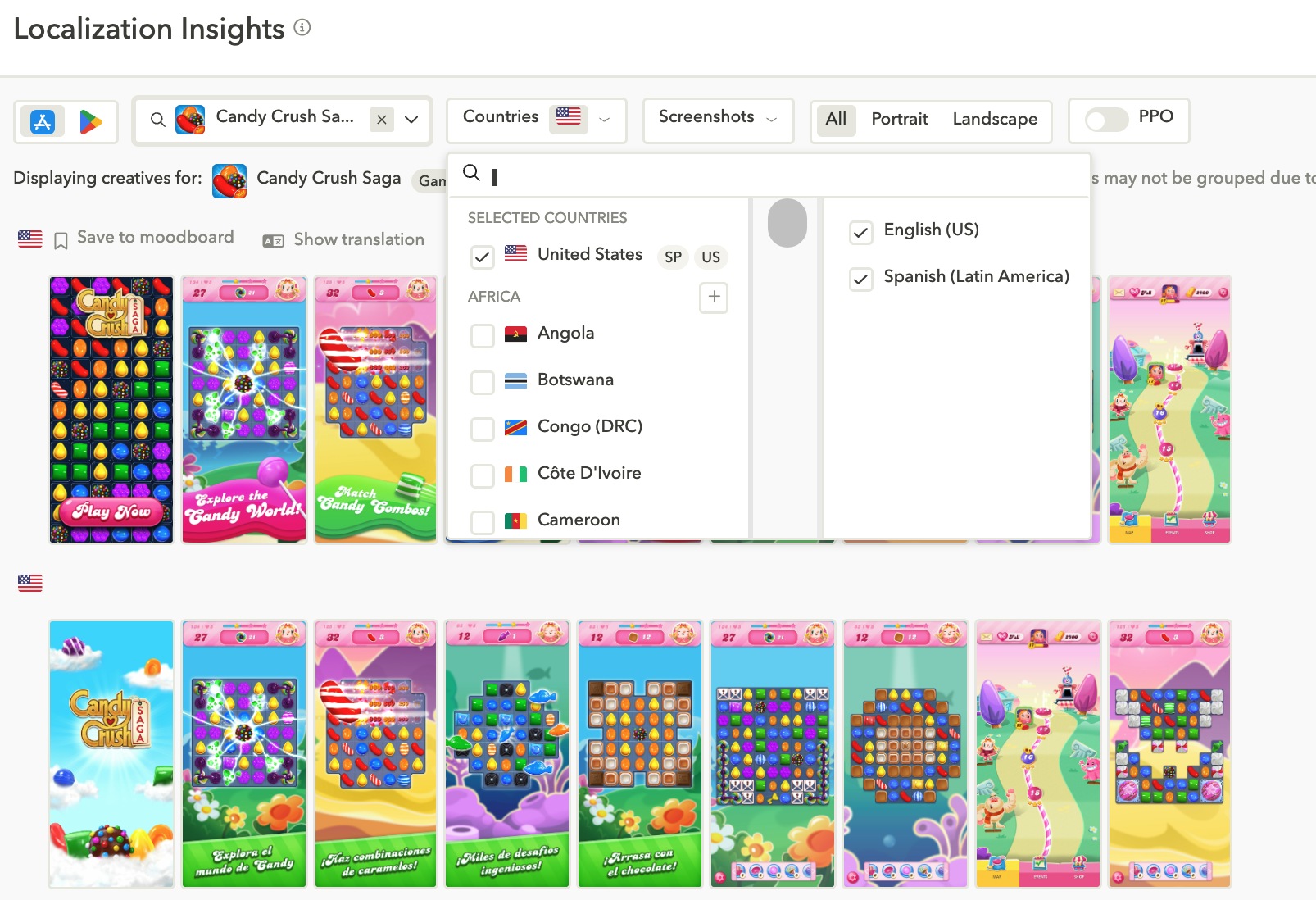
Another popular mobile game, Ludo King, localized into 15 languages, including multiple Indian regional languages. This focus on mobile app localization helped it become one of the most downloaded mobile games in the world, crossing 1 billion downloads.
Lithuanian-based Dogo, a wildly popular dog-training app, focused on mobile app localization from day one. By localizing into ten languages, Dogo successfully expanded to 221 countries, significantly growing its global user base.
Take a look at how the app appears for Portuguese users on the App Store.

How does localization differ across Google Play and the App Store?
Although the core goal of mobile app localization is the same for both app stores– adapting your app to better reach and engage users in different target markets–the App Store and Google Play each come with their own localization rules, localized fields, and best practices.
Below, we break down these differences to help you craft a more effective app store localization strategy for each platform.
Metadata fields and submission process
Both marketplaces support localized metadata, but the structure and flexibility of fields differ significantly.
Google Play allows developers to localize the app title, short description, and full description for over 70 languages. You can manage this directly in the Google Play Console or upload localized files via translations.
App Store localization is configured in App Store Connect, where you can localize your app title, subtitle, keywords, description, promotional text, and screenshots.
Expert Tip
Apple enables you to configure different keyword sets for each locale in App Store Connect. This means you can optimize your app’s discoverability based on how users search in different countries. AppTweak’s powerful ASO tool helps you make the most of this feature by identifying high-volume, low-competition keywords for each target market, so you can build a localized ASO strategy that drives results.In terms of submission, Google Play supports staged rollouts and simpler listing updates, while the App Store submissions require manual review, making iteration cycles longer. So, keep this in mind when planning ASO localization for your app.
Asset and creative requirements
Visual assets, like screenshots and video previews, play a big role in the performance of app localization. But the rules vary by store, as we detail here in our app screenshot, icon, and video size guidelines.
On the App Store, screenshots must be localized per device size and language. This means each market and device type (e.g., iPhone, iPad) may need its own set of visuals to reflect localized UI, language, and regional appeal.
Google Play offers flexibility through custom store listings, which can be targeted by per country or language. This feature allows you to create up to 50 tailored listings with completely different screenshots, videos, and descriptions tailored to each audience, which is a major advantage for mobile marketers who want full creative control.
Localized videos are optional on both stores, but each platform handles them differently.
Google Play supports both portrait and landscape formats and offers detailed performance metrics, helping marketers understand how each video variant impacts conversions.
On the App Store, you can upload up to three preview videos per locale, but they must match the device type (e.g., iPhone or iPad) and follow strict format guidelines. While performance data is more limited, these videos still offer a valuable opportunity to connect with users in a culturally relevant way.
In-app experience expectations
Users expect consistency between the app store listing and the in-app experience. App localization that stops at the metadata level often leads to friction.
On both app stores, users are likely to bounce if the app opens in a different language than the store page, so full in-app localization, including UI, onboarding, and support content is expected.
Google recommends tying language preferences to the device’s language settings, while Apple emphasizes using the preferred language order from the user’s iOS settings.
Localized support, push notifications, and in-app messaging can also improve engagement and app store ratings.
Table of app store localization: Google Play vs. the App Store
| App localization: Google Play vs. the App Store | ||
|---|---|---|
| Category | Google Play | The App Store |
| Metadata fields | Title, short description, long description; localized in 70+ languages | Title, subtitle, keywords, promo text, description |
| Keyword targeting | Keywords pulled from title / description (no dedicated field) | Dedicated keyword field per locale |
| Custom store listings | Yes, up to 50 per language / region | Not supported |
| Submission process | Faster; supports staged rollouts and updates without full review | Manual review for each submission; can slow iteration |
| Screenshot localization | Optional, but highly recommended; customizable per listing | Required per device size and language |
| Video previews | Supports portrait and landscape; localized versions per listing allowed | Max. 3 videos per locale; must match device type and be manually uploaded |
| In-app language handling | Follows device language; fallback to default if not available | Follows user’s preferred language order set in iOS settings |
| Localization tools | Google Play Console, translation service integrations (Google Translate) | App Store Connect, Xcode localization, Apple’s native export / import tools |
| UX expectation | Localized app experience expected; strong impact on retention and reviews | High expectations for full in-app localization; mismatches can affect ratings |
Key components of a successful app localization strategy
Effective app localization begins with planning. Start by understanding your audience and where your traffic is coming from. Then, dive into market research to explore your target users across global regions, and only after that, build a localization strategy tailored to each region’s cultural and economic context.
Include these essentials into your localization strategy.
Market research and prioritization
Start by analyzing where your app is already gaining traction even without localization, and then, look at competitors’ performance in various regions.
When evaluating potential markets, consider:
- Market size and mobile penetration
- Language demand vs. saturation
- Monetization potential (in-app purchases, ad revenue)
- Cultural fit for your app’s concept, content or use case
Prioritize markets that show high growth and monetization potential and align with your app’s strengths. From there, build a phased rollout plan, starting with the most strategic markets first.
Keyword research in target languages
App localization strategy is a cornerstone of ASO. Directly translating your English keywords won’t cut it, since users search differently in every language.
To localize your app for a target language, use local keyword tools, such as AppTweak, to:
- Identify high-volume, low-competition terms in each language
- Spot regional search behavior and trends
- Tailor keywords to how real users describe your app’s value
- Track and analyze competitor keywords in each locale to uncover gaps
In some markets, generic terms work well. In others, cultural nuance or slang may outperform literal keywords.
Adapting metadata and creatives for each market
Beyond keywords, your app title, subtitle, description, and creative assets (screenshots, preview videos, icons) should be localized for both language and cultural context.
- Textual elements should reflect tone, humor, or calls to action that feel native to the audience
- Visual assets may need regional tweaks: showing local currencies, relevant imagery, or culturally appropriate characters
- Consider A/B testing different creatives to see what resonates most in each market.
Calm, a well-known app for meditation and relaxation, uses localized imagery in screenshots to reflect regional preferences for relaxation, such as natural landscapes familiar to each audience.
For example, in Canada, visuals may show some mountains, while in Japan, they feature locally recognizable landscapes.
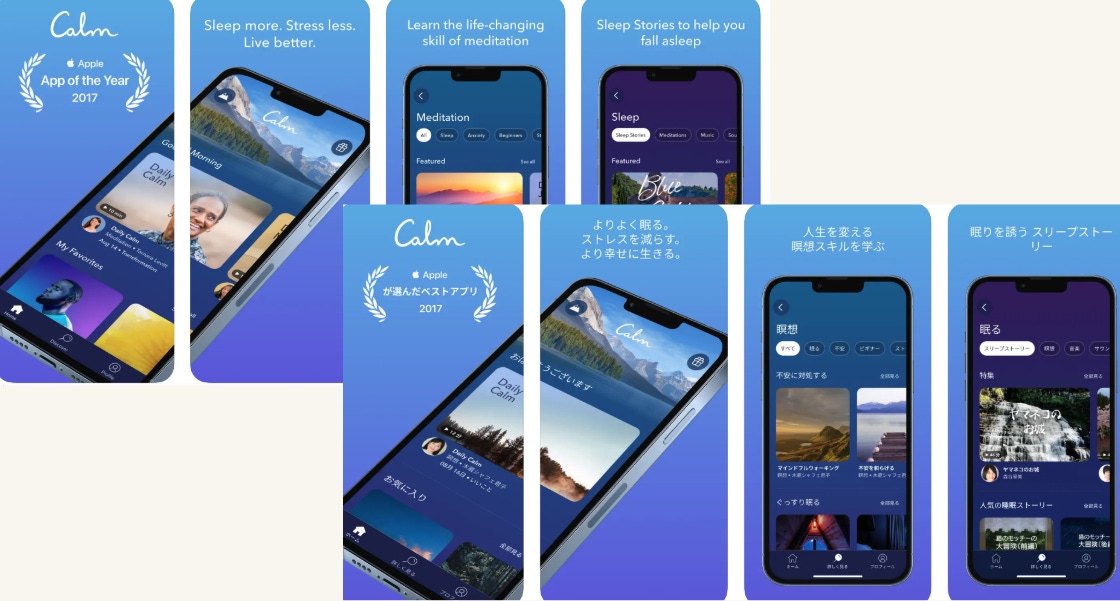
A step-by-step guide to localizing your app store listings
Effective app store localization begins with planning, and a strong strategy doesn’t stop at translation. It considers language, culture, user expectations, and even regulations. Here’s a structured approach to launching localized versions of your app that don’t just reach more people: they convert better, too.
Step 1: Audit your current metadata, assets, and in-app content
Start by reviewing everything in your app’s store presence: title, subtitle, descriptions, keywords, screenshots, and videos. Analyze what’s working, what’s missing, and what needs app localization. Make sure your in-app experience is aligned with your store listing: a mismatch in language or tone between the two can hurt retention and reviews.
Step 2: Benchmark competitors in target markets
Before localizing, examine how your top competitors present themselves in each region. What tone do they use? Which keywords do they rank for? How do their visuals differ across languages? This step reveals gaps you can exploit and sets a quality bar to exceed.
Keep an eye on competitors, spot potential threats, and discover new opportunities with AppTweak’s Competition Monitoring.
Step 3: Choose priority languages and markets
Use your analytics to identify where your app already has organic traction, where user interest is growing, and which regions show stronger monetization potential. Prioritize high-opportunity markets where localization could notably boost acquisition or engagement.
Step 4: Conduct keyword research for each market
Local keyword research is foundational to ASO. Don’t rely on translated keywords; instead, use tools like AppTweak to find how users actually search in their native language. Look for high-volume, low-competition keywords that reflect real user intent.
Step 5: Translate and adapt your metadata
Translate your title, subtitle, and description, but go beyond word-for-word translation. Adapt tone, value messaging, and cultural references to connect with local users. Be sure your keyword strategy is seamlessly integrated into the localized copy.
Step 6: Design localized creative assets
Update your visuals to reflect local expectations, including translated UI, relevant imagery, and culturally appropriate characters. If you’re targeting Japan during Golden Week, show content that reflects that. If you’re launching in Brazil, during the Carnival of Brazil, adjust tone and visuals accordingly if that’s in line with your branding.
For example, in the image below, you can see how the app Photoshop Express Photo Editor included regional elements, including localized photos and texts for its different screenshots in India, Germany, and France.
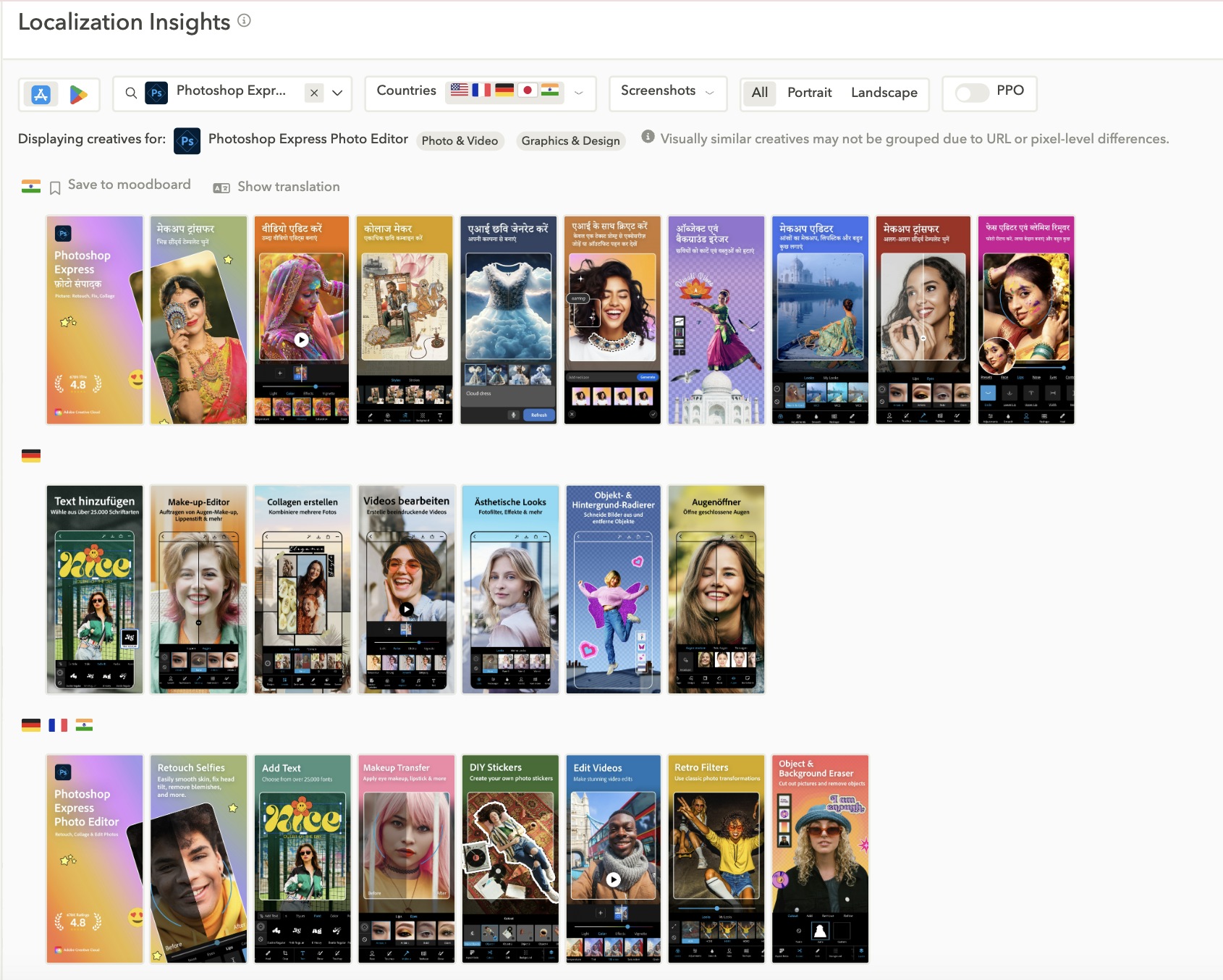
Step 7: Perform localization quality assurance with native reviewers
Before launching, involve native speakers or professional localization testers to review all localized elements, both in-store and in-app. This ensures content sounds natural, avoids cultural missteps, and aligns with regional norms.
Step 8: Check for legal and regulatory compliance
Certain markets, like the EU, China, or South Korea, have region-specific laws around privacy, content, and advertising claims. Ensure your store listing and in-app messaging comply with local standards to avoid rejections or fines.
Step 9: Implement, test, and optimize
Deploy your localized listings and track how they perform. On Google Play, leverage inbuilt A/B testing to compare different headlines, screenshots, or value propositions. For the App Store, use external A/B testing solutions like AppTweak. Monitor technical performance as well, from loading issues to incorrect language displays.
Step 10: Track performance and iterate
Track metrics and use this data to refine your keywords, update visuals, or prioritize new markets. Treat app localization as an ongoing optimization process.
Focus on these key KPIs for localization:
- Impressions per locale: Are your listings gaining visibility in each market?
- Conversion rate (CVR): Are users in your target regions installing the app after viewing your store page?
- Tap-through rate (TTR): On Apple Ads, are your localized creatives generating interest?
- Ratings and reviews by market Are local users satisfied with the app experience?
- Keyword rankings per locale: Are your localized keywords driving discoverability?
- App store traffic sources: Are users finding your app via search, browse, or paid campaigns?
AppTweak’s localization tips by country
AppTweak’s experts regularly share mobile app localization tips for various countries and regions. Let’s check a few examples and see how much the approach varies from market to market. For a deeper dive, check out our blog on how to translate app screenshots for new localization insights.
Localizing your app for India
Hindi is India’s most prevalent language, but it’s not the mother tongue for almost 60% of Indians. This country is linguistically diverse, so if you’re targeting this market, mobile app localization should go beyond Hindi.
Top languages to consider include Hindi, Tamil, Telugu, Bengali, Marathi, Kannada, and Malayalam. To find more tips on app localization for India, including creatives localization and culturalization, read the blog: How to localize your app for India.
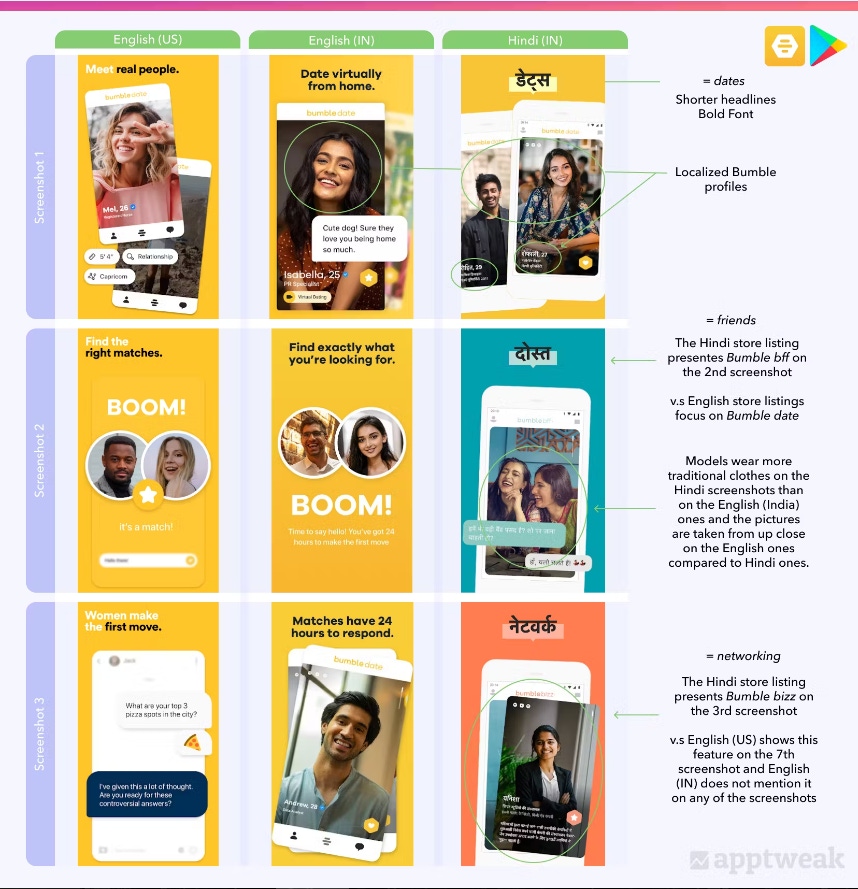
Localizing your app for France
French is one of the most popular languages supported by the app stores. France and Canada are the two main markets in which you can target French-speaking audiences.
App localization tips for France:
- Many anglicisms are integrated in French, so you may use them too. But be careful: some anglicisms have a different meaning in Frenchr than in English. So, double check with native speakers before launching app localization for France.
- Skipping French accents in titles or subtitles might boost search results, but in longer text descriptions, it can look like a mistake and hurt your app’s credibility.
- Regarding screenshots, apps in France prefer to use darker and more straightforward designs.
Find even more tips on app localization for France in this insightful blog: How to localize your app for France.
Localizing your app for Singapore
Despite being a relatively small country, Singapore has a high GDP per capita. So, it might be worth your app localization efforts.
Notes for app localization for Singapore:
- English and Simplified Chinese are the two locales available on the Singaporean Play Store.
- Translate your short and long description into Simplified Chinese for your Chinese store listing.
- English titles tend to perform well in Singapore, even on the Chinese store listing.
- QR code scanners and anime are very popular in Singapore.
More insights on mobile app localization for this promising market you’ll find here: How to localize your app for Singapore.
Tools to help you localize your app effectively
Here are the tools that make the ASO localization process faster, more accurate, and easier to manage across multiple markets.
- AppTweak: App localization support for both Google Play and the App Store, with unique ASO and Apple Ads insights.
AppTweak just launched Localization Insights, first-to-market feature for AI-powered localization of text on your screenshots. This new functionality takes your app localization to the next level: translate the copy on the screenshots to any language in just a couple of clicks.
Interested? Explore now.

- Lokalise, Crowdin, Phrase: Powerful platforms for managing translation and localization workflows.
- Google Play Console and App Store Connect: Built-in tools for adding localized metadata and creative assets on Google Play and the App Store.
- Gengo, TextMaster, Deepl Pro: Translation APIs with options for professional human review.
Common mistakes to avoid in app store localization
If you’re committed to spending time and resources for app localization, these are the top pitfalls you need to avoid.
Not localizing at all
Skipping app localization entirely means missing out on organic growth in high-potential markets. Even a few strategic languages can dramatically increase your reach and conversions.
Localizing too early
Jumping into mobile app localization before achieving a product-market fit or stable retention can waste resources. Focus first on refining your core product and messaging in your primary market.
Wasting budget on low-opportunity markets
Not every region justifies the investment. Use research and data instead of guesswork to prioritize markets with strong demand, monetization potential, or current organic traction.
Ignoring legal and app store compliance
Each app store and country has specific guidelines and best practices around keywords, screenshots, messaging and content. Violations can lead to rejections and slow down the approval process significantly.
Publishing screenshots without previewing and testing them
Visual missteps, like untranslated UI, broken layouts, or off-brand imagery, are likely to kill your conversions. Resort to tools like AppTweak’s App Page Preview to catch errors before going live and make your ASO localization launch flawless.
Treating localization like simple translation
Word-for-word translation won’t connect with users. Without adapting tone, visuals, or value messaging to the cultural context of the region, your app can come across as generic or even confusing, and eventually lose users you were trying hard to reach.
Forgetting to localize in-app content
A fully localized store listing won’t help if your app still launches in English. Ensure your in-app experience matches the promises you make in the store to avoid user frustration and consequently churn.
Neglecting seasonal app localization
Not localizing for seasonality is a subtle but important pitfall. You could be missing out on opportunities to capture users during seasonal events and holidays in your target markets.
For example, during Chinese New Year, you can add festive elements to your screenshots or even the app icon. If Japan is your target market, adding cherry blossoms to your creatives in spring can make your app feel more relevant.
In European markets, you could reflect Christmas themes in December with snowflakes or gift imagery, or highlight Easter with pastel colors and themed visuals. In Germany, incorporating seasonal elements for Oktoberfest, like traditional patterns or festive elements, can help your app feel relevant and catchy.
Real-world success stories: App growth through localization
As we’ve discussed, app localization isn’t just about translating language, it’s about understanding culture. But the language does matter.
How cultural nuances impact app performance
A great example comes from optimizing casino games for the Australian market. One of AppTweak’s app growth experts was running tests for slot games, and while creatives were performing well in the U.S., they flopped in Australia. The reason? A single word.
In Australia, players don’t call these games “slots”. They call them “pokies”. That small cultural and linguistic nuance was enough to derail performance, even with polished visuals. Once the team swapped in locally relevant terminology, engagement immediately improved.

Expert Tip
AppTweak built the AI-powered Screenshot Library to help mobile marketers uncover what truly resonates in each market. You can search app store creatives by country, genre, or even design style, and see how top-performing apps are localizing their visuals and messaging.Want to see how competitors in Australia talk to their audience? You can instantly analyze creative patterns, validate ideas through Localization Insights, and save screenshots to share with your design team.
If your A/B test performs in one country but flops in another, the problem might not be your creative quality, but rather the cultural fit. The Screenshot Library helps you bridge that gap faster.
How to scale globally with localized product pages
One more success story worth mentioning here: iVisa, a travel documentation app, launched and localized their custom product pages with support from AppTweak to make their app store presence relevant to multiple high-potential markets.
As a result, Visa’s Apple Search Ads campaigns in South Korea, New Zealand, and Australia saw a significant decrease in their CPI, helping iVisa to save over $12,000 in 6 months.
Conclusion
App localization is a must-have for any app aiming to expand its reach, connect with international audiences, and scale effectively. It’s not just about translation: without cultural context, even the most accurate wording can fall flat or confuse users.
So, if you’re targeting global markets, tailor your text, creatives, and overall app store presence to match the cultural expectations and unique traits of each region. Know that AppTweak is here to help you streamline the entire localization process: from market research and competitor analysis to optimizing your creatives and translating the copy on your screenshots on the fly.
FAQ
Below we answer your frequently asked questions for mobile app localization.
What is app store localization?
App store localization is adapting your app’s store listing, including text, visuals, and keywords, to fit the language and culture of different target markets. It helps make your app more appealing and accessible to users worldwide.
What is the difference between app localization and translation?
Translation is simply converting text from one language to another, while localization involves adapting content to cultural specificities and regional preferences beyond just language. Localization ensures the app feels native to the target audience.
Which countries should I prioritize for localization?
Prioritize countries with high app usage in your category and where your app can fill a market gap. Also consider countries with strong purchasing power and where your competitors have less presence.
How do I localize my app?
Start by translating and culturally adapting your app store listing, including descriptions, screenshots, and keywords. Then localize the in-app content to meet local user expectations.
How do I localize both iOS and Android apps?
Use platform-specific tools like Xcode (for iOS) and Android Studio (for Android) to localize your app’s in-app content and UI elements. For your app store listings, localization needs to be handled separately through App Store Connect and the Google Play Console, including metadata, screenshots, and preview videos.
To streamline the process, you can use AppTweak to localize your metadata and creative assets more efficiently. With tools like Localization Insights and the AI-powered Screenshot Library, AppTweak helps you adapt your store listing content (text and visuals) for each market based on local trends, language, and cultural preferences.
What are the common mistakes in ASO localization?
Common mistakes include direct translations without cultural adaptation, localizing too early, neglecting app store compliance, and wasting budget on low-opportunity markets.
What are the benefits of app store localization for app visibility?
Localization boosts app visibility by improving keyword relevance and user engagement in target markets. It also increases downloads and revenue by making the app accessible to a wider audience globally, expanding your app business and your bottomline.

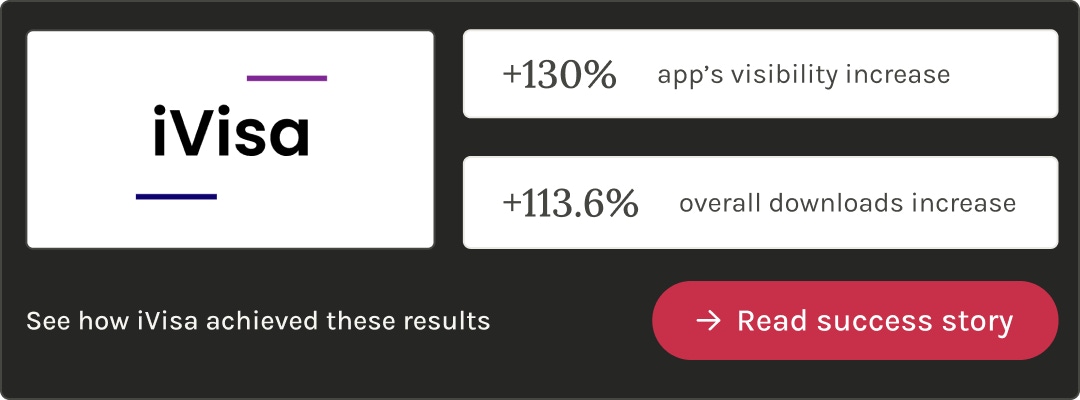


 Elizabeth Devine
Elizabeth Devine

 Ian Pernia
Ian Pernia

 Justin Duckers
Justin Duckers